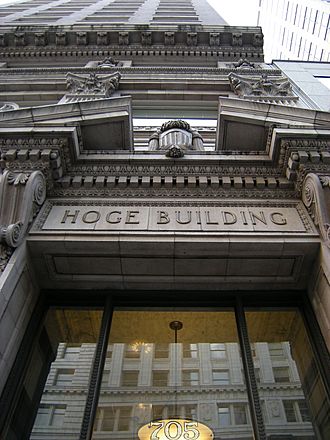Hoge Building facts for kids
Quick facts for kids Hoge Building |
|
|---|---|
 |
|
| Record height | |
| Tallest in Seattle from 1911 to 1914 | |
| Preceded by | Alaska Building |
| Surpassed by | Smith Tower |
| General information | |
| Address | 705 Second Avenue Seattle, Washington |
| Named for | James D. Hoge, Jr. |
| Construction started | 1909 |
| Completed | 1911 |
| Renovated | 1992 |
| Height | |
| Roof | 205 feet (62 m) |
| Technical details | |
| Floor count | 17 |
| Design and construction | |
| Architect | Bebb & Mendel |
|
Hoge Building
|
|
| Location | Seattle, Washington |
| Built | 1911 |
| Architect | Bebb & Mendel |
| Architectural style | Beaux-Arts |
| NRHP reference No. | 83003339 |
| Significant dates | |
| Added to NRHP | April 14, 1983 |
The Hoge Building is a tall, historic building in Seattle, Washington. It has 17 stories and was finished in 1911. It was built by and named after James D. Hoge, who was a banker and real estate investor. You can find it at the corner of Second Avenue and Cherry Street. For a few years, from 1911 to 1914, it was the tallest building in Seattle! The building is made mostly of tan brick and terracotta (a type of baked clay). It has a strong steel frame inside and was designed in a style called Second Renaissance Revival, with parts of Beaux Arts architecture.
Building History
From Cabin to Skyscraper
The land where the Hoge Building stands today has a long history. It was once the spot of Carson Boren's cabin. This cabin is thought to be the first house built by a white settler in what would become Seattle. Later, small shops were built on this site. However, all these buildings were destroyed in the Great Seattle fire of 1889.
Soon after the big fire, James D. Hoge's uncle, John Hoge, bought the land. He was a rich businessman from Ohio. John Hoge then built a three-story brick building there. This building housed his company, the Washington Territorial Investment Company, and other businesses.
Building a Landmark
James D. Hoge started his own bank in 1903. It was first called Union Trust & Savings Bank. This bank would later become a main tenant on the ground floor of his new building.
Hoge hired famous architects Charles Bebb and Louis Mendel to design the Hoge Building. Construction started in March 1911. The steel frame of the building went up incredibly fast. All 18 stories were completed in just 30 days! This was a record-breaking speed at the time. The architects also designed the building to be very strong. They paid special attention to making it safe during earthquakes. This was because of the big 1906 San Francisco earthquake that happened a few years earlier.
Life of the Building
The Hoge Building was the tallest in Seattle from 1911 until 1914. That's when the Smith Tower was finished and became even taller. Over the years, many businesses have been in the Hoge Building. For example, a branch of Dexter Horton Bank was located there in 1991. More recently, a Bank of America branch was on the ground floor. The Hoge family owned the building until 1986.

